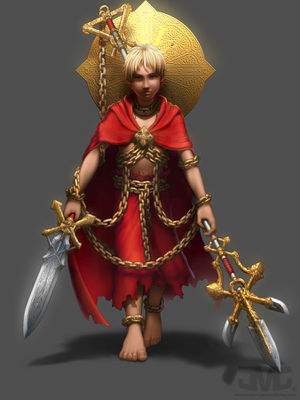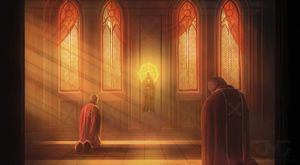Nikina: Difference between revisions
No edit summary |
No edit summary |
||
| Line 5: | Line 5: | ||
He generally appears as a male child between ten and thirteen years of age, with the exact same outfit every time: A heavy red cloak fastened with a golden brooch, a red skirt that reaches his ankles, and twenty-one golden chains wrapped around him in a specific design. During very important formal meetings, he appears with a golden disc hovering behind his head, with similar designs to both the brooch of his cloak and the designs that appear on weapons he has held in the past. Ethnically, he does not represent a specific group in Riiga. His hair is similar to many golden-haired people of Seleru but his eyes change colour and his skin is not so dark and he does not share features with these people. Despite this, Nikina's appearance is one of the reasons for the popularity of golden hair, especially in Margon. Despite the gold on his body looking like regular pure gold known to man, it is not confirmed. | He generally appears as a male child between ten and thirteen years of age, with the exact same outfit every time: A heavy red cloak fastened with a golden brooch, a red skirt that reaches his ankles, and twenty-one golden chains wrapped around him in a specific design. During very important formal meetings, he appears with a golden disc hovering behind his head, with similar designs to both the brooch of his cloak and the designs that appear on weapons he has held in the past. Ethnically, he does not represent a specific group in Riiga. His hair is similar to many golden-haired people of Seleru but his eyes change colour and his skin is not so dark and he does not share features with these people. Despite this, Nikina's appearance is one of the reasons for the popularity of golden hair, especially in Margon. Despite the gold on his body looking like regular pure gold known to man, it is not confirmed. | ||
The two main symbols of Nikina are the aforementioned golden disc which is commonly represented as a circle with cardinal points. This symbol is only used by Nikina himself, and occasionally | The two main symbols of Nikina are the aforementioned golden disc which is commonly represented as a circle with cardinal points. This symbol is only used by Nikina himself, and occasionally extensions of Nikina, such as [[Shimteak]]. It is considered sacrilege for mortals to use this symbol, normally called a halo. The other symbol is the X with a point at each end, which has two main meanings behind it. The first meaning is that the four points represent the four aspects of Nikina listed below, and the second is that it represents the crossing of golden chains over his chest. This X symbol is used commonly to represent the Red Temple. | ||
==Nikina's Eyes== | ==Nikina's Eyes== | ||
Revision as of 17:50, 8 April 2021
Nikina -- also known as the Child God, the One of Many, the Child of Man, or the Bound One or Chained One -- is the primary god of creation in the Red Temple religion. Nikina physically meets high priests and kings in one of two red temples -- one in Lyte and one in Umburn. He claims that it is his power that led to the presence of Hireos god-kings in Benevis, such as King Renin. He is associated with creation, justice, peace, and morality, and is the enemy of Garukavar.
He generally appears as a male child between ten and thirteen years of age, with the exact same outfit every time: A heavy red cloak fastened with a golden brooch, a red skirt that reaches his ankles, and twenty-one golden chains wrapped around him in a specific design. During very important formal meetings, he appears with a golden disc hovering behind his head, with similar designs to both the brooch of his cloak and the designs that appear on weapons he has held in the past. Ethnically, he does not represent a specific group in Riiga. His hair is similar to many golden-haired people of Seleru but his eyes change colour and his skin is not so dark and he does not share features with these people. Despite this, Nikina's appearance is one of the reasons for the popularity of golden hair, especially in Margon. Despite the gold on his body looking like regular pure gold known to man, it is not confirmed.
The two main symbols of Nikina are the aforementioned golden disc which is commonly represented as a circle with cardinal points. This symbol is only used by Nikina himself, and occasionally extensions of Nikina, such as Shimteak. It is considered sacrilege for mortals to use this symbol, normally called a halo. The other symbol is the X with a point at each end, which has two main meanings behind it. The first meaning is that the four points represent the four aspects of Nikina listed below, and the second is that it represents the crossing of golden chains over his chest. This X symbol is used commonly to represent the Red Temple.
Nikina's Eyes
Nikina has four colours of eyes, and when they change it means he is in a different aspect of his being. He is essentially four gods sharing one form and mind.
- Blue eyes means Mohaxamilia. A being of birth, growth, kindness, innocence, joy, love, passion, prosperity, and humility. (Mohax, Maxamilia)
- Green eyes means Nikina. This form is associated with omnipresence, omniscience, wisdom, guidance, light, energy, power, and holiness.
- Gold eyes means Lexander. A being of spirit, soul, the next life, formality, intelligence, journeys, silence, and maturity. (Xander, Lexand)
- Red eyes means Hadrinaeltrios. A being of peace, choice, violence, protection, education, war, strength, music, and creation. (Hadrin, Adrinael, Eltrios)
Nikina's Role
Though he often gives counsel to the high priests and kinds of Benevis in dire times, Nikina has never directly influenced any events, even when monsters attack; he seems to command his Shimteak to intervene on his behalf. Neither do the other gods known in the Red Temple religion -- Ilertav and Leuvana -- ever appear or seem to help humanity in any way. But military orders do exist who act as Nikina's warriors, such as the Venquis. Instead, Nikina has offered many historical accounts in the past -- especially on matters regarding the enemies of humanity -- and will sometimes give details on other deities of other religions. Nikina once warned the people of imminent monster attacks, but has since stopped doing this. Benevis now relies on synavos for such warnings.
Creeds
Though the Red Temple is unified under the authority of the high priests of Umburn and Lyte, there are different creeds operating within the religion itself, separated by minor differences in belief and practice, though all creeds believe in Nikina as the primary god and force of good, and that the sacred text known as the Dutri as the source of doctrine. The creeds are the Dualkedorians of Margon, Arkein, and Simbea; the Arngosians of Umberia, Granland, Vastin, and Regyland; and the lesser creeds of Abadorians of Asshor, Satium, and Maugnun, and the Prielics of Laviscon, Solusia, Velena, Curin, and Yaele.
Dualkedorians
They believe that there is a dichotomy of good and evil in the world and that it is the duty of the good to fight against the evil. They believe Nikina's four aspects are separate minds and wills but sharing the one body. They fully endorse the Venquis and protect them under sacred law. They believe that Forganad is the only true force of harmony in Riiga, operating from outside the material world in unseen ways.
Arngosians
They believe that there is a dichotomy of good and evil in the world and that it is the duty of the good to fight against the evil. They believe that Nikina is one mind and will but the aspects are different facets of him. They fully endorse the Venquis and protect them under sacred law. They do not endorse belief in Forganad and do not think there is a divine force of harmony.
Abadorians
They believe that there is a dichotomy of good and evil in the world and that it is the duty of the good to fight against the evil. They believe that Nikina is one mind and will but the aspects are different facets of him. They do not oppose the use of Venquis, and they do protect them under sacred law, but they do not employ their use directly. They believe that Forganad is the only true force of harmony in Riiga, operating from outside the material world in unseen ways.
Prielics
They believe that it is possible to be neither good nor evil, such as with animals or children, but it is still the duty of the good to fight for the neutral. They believe Nikina's four aspects are separate minds and wills but sharing the one body. They do not utilise Venquis in this part of the world, but they do not reject them as a part of the Red Temple. They do not endorse believe in Forganad and do not think there is a divine force of harmony.

